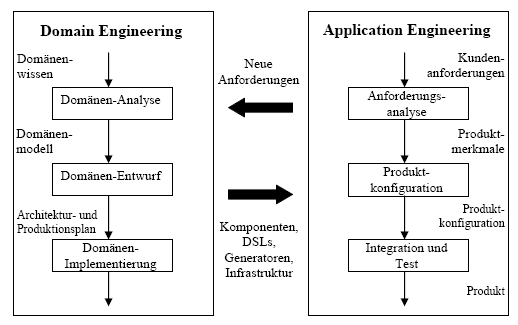3.2.2.1 Generative programming
On the basis of the requirements of software development, already described, the holistic Generative models programming of software systems in such a way that "on the basis of a requirement specification by means of configuration knowledge from elementary, re-usable implementation components an high-adapted and optimized Zwischenoder final product can be produced for "86 as required automatically.
In addition the Generative programming uses methods and techniques co-ordinated one on the other for the development of software system families. Substantial components of the Generativen of programming are to a large extent automatic the characteristic-based modelling requirements determined by thing in common and differences of the family members and the development from language means to the description of individual systems as well as the development of generators, the this due to produce87.
The proceeding of the Generativen of programming is represented in the following illustration:

Illustration 4: Computer family development after Czarnecki88
In addition tables and libraries must develop, which the appropriate knowledge over dependence, reciprocal effects, descriptions, origin and use of characteristics, as well as the standard defaults, connection times etc. to log. From this can be derived, which functions in the basic system compellingly to belong to to have and which in family members to be realized be able optional. But must be examined, which relevant components in appropriate categories of different implementations to be summarized to be able and which dependence exist.
Foundation-stone of this procedure is the Generative Domain Model, which contains the problem area, This the specialist areas and the specific requirements, the solution area, which describes all components of the system, and which configuration knowledge, which supplies the structural drawing for the components for the solution of concrete problem descriptions.
These results flow into the draft of the flexible software architecture for the complete application family and become then from again usable components, a domain-specific specification language which Domain Specific LANGUAGE implements, developed for it, and from configuration generators.
The results of the Domain engineering are similar a kind catalog for possible automatic derivatives to an offer brochure of car manufacturers. This catalog is the basis for the development of genuine applications of customers in the Application engineering. Here the specific customer requirements are raised and built up by means of the existing components, languages and generators by Templates and the configuration knowledge. Requirements, which are again raised here, flow over the necessary configuration management again into the Domain engineering ein90.
The procedure of the Generativen of programming has following pro and cons:
| Evaluation of the Generative Programming91 |
| Advantages | Disadvantages |
|
|
Table 14: Evaluation of the Generativen programming
- 86: See [Czar 2001-2] foil 8
- 87: See [ice 2003-2] P. 1 FF
- 88: See [Czar 2001-2] foil 7
- 89: The completely model-based commercial Plugin of the company of pure system GmbH supports the development and derivative of computer families, by translating characteristic models for these examined and by means of its own transformer independently into family members with the help of existing components. See [pure 2005]
- 90: See [ice 2003] technology and [Czar 2001-02] foil 7 FF
- 91: See [Tamm 2004] P. 1 FF, [Benz 2003] P. 1 FF and [Brüg 2005]